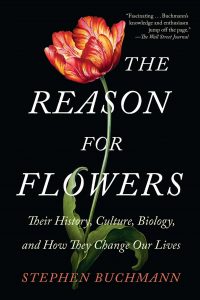The Reason for Flowers
Posted in From the Library on October 17 2016, by Esther Jackson
Esther Jackson is the Public Services Librarian at NYBG’s LuEsther T. Mertz Library where she manages Reference and Circulation services and oversees the Plant Information Office. She spends much of her time assisting researchers, providing instruction related to library resources, and collaborating with NYBG staff on various projects related to Garden initiatives and events.
 The Reason for Flowers is the most recent book from pollination ecologist and entomologist Stephen Buchmann. Buchmann’s primary research is focused on pollinators, and several of his earlier books are specifically about bees.
The Reason for Flowers is the most recent book from pollination ecologist and entomologist Stephen Buchmann. Buchmann’s primary research is focused on pollinators, and several of his earlier books are specifically about bees.
Flowers, as Buchmann writes, are an integral part of human history. Flowers (or plants, more generally) are cultivated, harvested, killed, eaten, admired, and imbued with a myriad of symbols. On top of human interactions with flowers, there are also pollinator interactions with flowers. In short, the scope of this book is enormous. Fourteen chapters in five sections cover topics from flower fossils to flowers in contemporary science. In between are sections detailing popular flowers in historic gardens from around the world, edible flowers, flowers in art and literature, and “healing” flowers.
My favorite section of the book detailed the flower trade. Who knew that there was a single Dutch auction house that funnels the majority of cut flowers in Europe, the Middle East, and Asia to their final destinations? (A good deal of readers probably knew that already—I, however, did not!) I was also fascinated by the very brief mention of the use of 3D printing to create artificial flowers for experiments with pollinators.
There is a lot of wonderful information in this book, and Buchmann clearly has a passion for the subject at hand. That said, there is far too much going on. I understand Buchmann’s desire to include all of the sections and information he has compiled, as it is the result of a great deal of research and personal experiences. However, the sheer magnitude of varying factoids and topics doesn’t ever fully draw the reader in before rushing on to something else. Reason may have been more successful had Bachmann focused on a handful of topics and stuck to more of a narrative form for each. (Examples of this include The Botany of Desire or The Cabaret of Plants.)
Ultimately, The Reason for Flowers is a quirky book that is worth a look for readers who are curious about flowers throughout history, or readers who want an introduction to pollinator-plant interactions with a literary flair.

